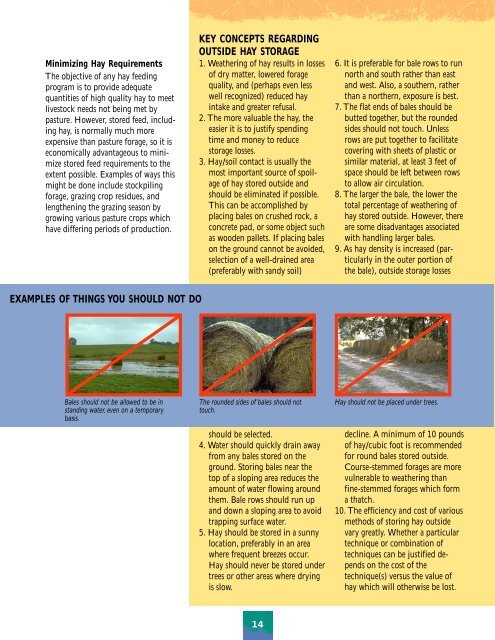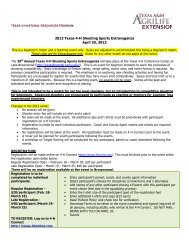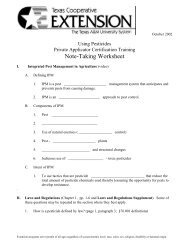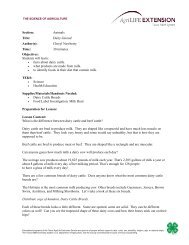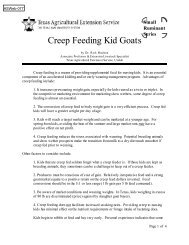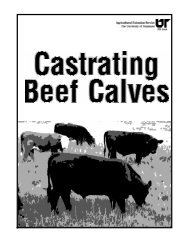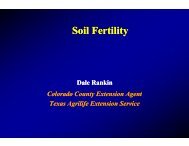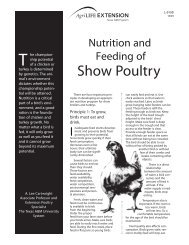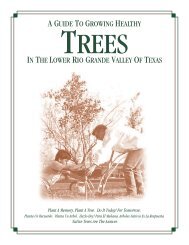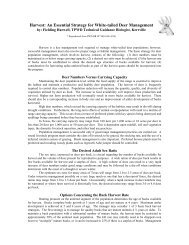Minimizing Losses in Hay Storage and Feeding - MSUcares
Minimizing Losses in Hay Storage and Feeding - MSUcares
Minimizing Losses in Hay Storage and Feeding - MSUcares
- No tags were found...
You also want an ePaper? Increase the reach of your titles
YUMPU automatically turns print PDFs into web optimized ePapers that Google loves.
<strong>M<strong>in</strong>imiz<strong>in</strong>g</strong> <strong>Hay</strong> RequirementsThe objective of any hay feed<strong>in</strong>gprogram is to provide adequatequantities of high quality hay to meetlivestock needs not be<strong>in</strong>g met bypasture. However, stored feed, <strong>in</strong>clud<strong>in</strong>ghay, is normally much moreexpensive than pasture forage, so it iseconomically advantageous to m<strong>in</strong>imizestored feed requirements to theextent possible. Examples of ways thismight be done <strong>in</strong>clude stockpil<strong>in</strong>gforage, graz<strong>in</strong>g crop residues, <strong>and</strong>lengthen<strong>in</strong>g the graz<strong>in</strong>g season bygrow<strong>in</strong>g various pasture crops whichhave differ<strong>in</strong>g periods of production.KEY CONCEPTS REGARDINGOUTSIDE HAY STORAGE1. Weather<strong>in</strong>g of hay results <strong>in</strong> lossesof dry matter, lowered foragequality, <strong>and</strong> (perhaps even lesswell recognized) reduced hay<strong>in</strong>take <strong>and</strong> greater refusal.2. The more valuable the hay, theeasier it is to justify spend<strong>in</strong>gtime <strong>and</strong> money to reducestorage losses.3. <strong>Hay</strong>/soil contact is usually themost important source of spoilageof hay stored outside <strong>and</strong>should be elim<strong>in</strong>ated if possible.This can be accomplished byplac<strong>in</strong>g bales on crushed rock, aconcrete pad, or some object suchas wooden pallets. If plac<strong>in</strong>g baleson the ground cannot be avoided,selection of a well-dra<strong>in</strong>ed area(preferably with s<strong>and</strong>y soil)6. It is preferable for bale rows to runnorth <strong>and</strong> south rather than east<strong>and</strong> west. Also, a southern, ratherthan a northern, exposure is best.7. The flat ends of bales should bebutted together, but the roundedsides should not touch. Unlessrows are put together to facilitatecover<strong>in</strong>g with sheets of plastic orsimilar material, at least 3 feet ofspace should be left between rowsto allow air circulation.8. The larger the bale, the lower thetotal percentage of weather<strong>in</strong>g ofhay stored outside. However, thereare some disadvantages associatedwith h<strong>and</strong>l<strong>in</strong>g larger bales.9. As hay density is <strong>in</strong>creased (particularly<strong>in</strong> the outer portion ofthe bale), outside storage lossesEXAMPLES OF THINGS YOU SHOULD NOT DOBales should not be allowed to be <strong>in</strong>st<strong>and</strong><strong>in</strong>g water, even on a temporarybasis.The rounded sides of bales should nottouch.should be selected.4. Water should quickly dra<strong>in</strong> awayfrom any bales stored on theground. Stor<strong>in</strong>g bales near thetop of a slop<strong>in</strong>g area reduces theamount of water flow<strong>in</strong>g aroundthem. Bale rows should run up<strong>and</strong> down a slop<strong>in</strong>g area to avoidtrapp<strong>in</strong>g surface water.5. <strong>Hay</strong> should be stored <strong>in</strong> a sunnylocation, preferably <strong>in</strong> an areawhere frequent breezes occur.<strong>Hay</strong> should never be stored undertrees or other areas where dry<strong>in</strong>gis slow.<strong>Hay</strong> should not be placed under trees.decl<strong>in</strong>e. A m<strong>in</strong>imum of 10 poundsof hay/cubic foot is recommendedfor round bales stored outside.Course-stemmed forages are morevulnerable to weather<strong>in</strong>g thanf<strong>in</strong>e-stemmed forages which forma thatch.10. The efficiency <strong>and</strong> cost of variousmethods of stor<strong>in</strong>g hay outsidevary greatly. Whether a particulartechnique or comb<strong>in</strong>ation oftechniques can be justified dependson the cost of thetechnique(s) versus the value ofhay which will otherwise be lost.14


